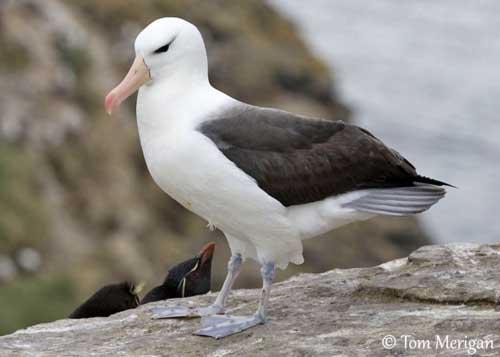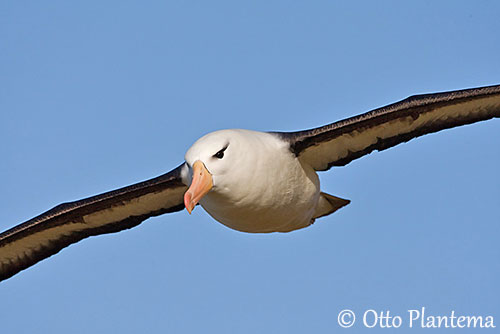
Fr: Albatros à sourcils noirs
All: Mollymauk
Esp: Albatros Ceja Negra
Ital: Albatro dai sopraccigli neri
Nd: Wenkbrauwalbatros
Sd: Svartbrynad albatross
Photographers:
Tom Merigan
Tom Merigan’s Photo Galleries
Otto Plantema
Trips around the world
Ingo Waschkies
Bird Photography
Text by Nicole Bouglouan
Sources:
HANDBOOK OF THE BIRDS OF THE WORLD vol 1 by Josep del Hoyo-Andrew Elliot-Jordi Sargatal - Lynx Edicions - ISBN: 8487334105
BirdLife International (BirdLife International)
New Zealand birds and birding (Narena Olliver)
Department of Sustainability, Environment, Water, Population and Communities
Australian Antarctic Division: Leading Australia's Antarctic Program
Wikipedia, the free encyclopaedia
Black-browed Albatross
Thalassarche melanophris
Procellariiforme Order – Diomedeidae Family
INTRODUCTION:
Formerly, two subspecies were included under the same name, with the nominate T.m. melanophris, and the other race T.m. impavida. They are now considered as separate species under the names Black-browed Albatross and Campbell Albatross, from recent genetic studies of DNA. However, some disagreement is continuing, suggesting that genetic divergences between the two subspecies are not sufficient to separate them.
(The Campbell Albatross is mentioned here in the subspecies, but it will be studied later as full species.)
DESCRIPTION OF THE BIRD:
Biometrics:
Length: 83-93 cm
Wingspan: 240 cm
Weight: 3000-5000 g. The race “impavida” is slightly smaller.

On the white head, the face is white except the black eyebrow over the brown eye. The bill is pinkish-yellow with darker pinkish-orange hooked tip. Legs and webbed feet are pale greyish-blue.
Both sexes are similar. They are long-lived birds (up to 50 and more).
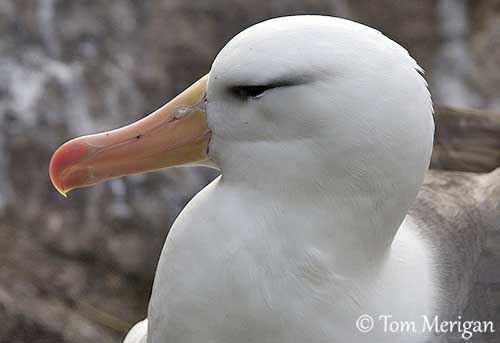
The juvenile has darker underwing, grey collar, dark bill with black tip and paler eyebrow.
The chick is covered with greyish-white down. It has white face and blackish bill.
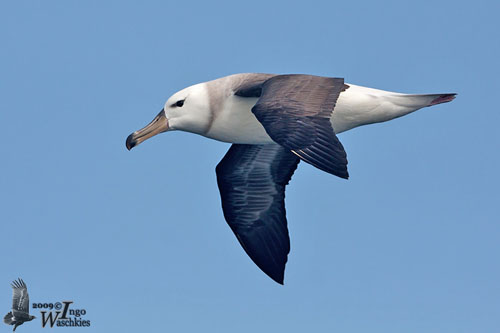
SUBSPECIES AND RANGE:
Two subspecies were formerly recognized:
T.m. melanophris (here described and displayed) is found in Southern Ocean, from Cape Horn, E to Antipodes islands.
T.m. impavida occurs on Campbell Island to S of New Zealand. This one has pale yellowish-white to pale amber eyes.
HABITAT:
The Black-browed Albatross is marine and pelagic to some extent. It can be commonly seen near the shore, but it also wanders far at sea, up to 1000 km from the coast. However, this species frequents inshore waters more than other albatrosses, and in bad weather, it enters estuaries, fjords and harbours.
Some observations mention birds feeding on freshwater lake at Tierra del Fuego, about 35 km inland.
It breeds on remote islands, with nests built on steep slopes among tussock grass, or on cliff ledges.
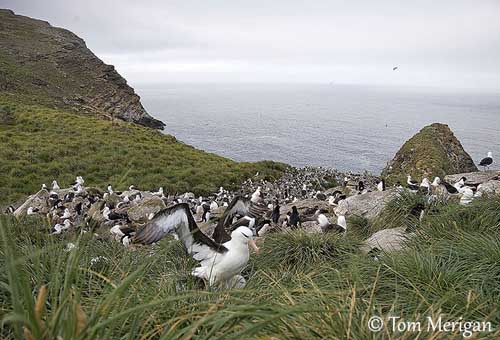
CALLS AND SONGS: SOUNDS BY XENO-CANTO
The Black-browed Albatross gives guttural grunting, croaks, wails and harsh cackle, but some other sounds such as throaty cries and moans can be heard during displays. They also produce the characteristic rattling sound with the bill.
Some difference in voice is reported between the two subspecies.
BEHAVIOUR IN THE WILD:
The Black-browed Albatross feeds on fish and crustaceans (mainly krill of genus Euphausia), squid and floating carrion. Preys are caught by surface-seizing, although pursuit-plunging or surface-plunging and surface-diving can be performed too. It may use its wings underwater, in order to propel itself when pursuing a prey. It may dive to depths of 4-5 metres and during several seconds.
It forages both night and day, according to the type of preys. It often feeds on large swarms, mainly krill, and follows the fishing boats and the cetaceans for debris and fish remains.
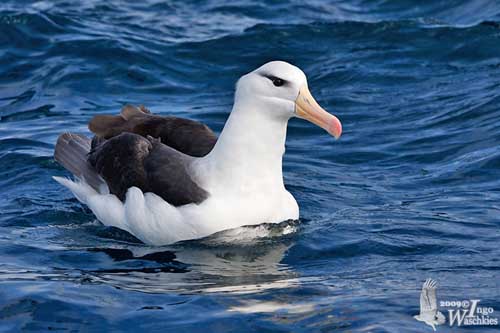
The Black-browed Albatross forages over continental and island shelves, and across adjacent underwater banks. But it also frequents oceanic waters. They often forage in flocks, and usually with other seabirds.
They return to the breeding colonies in September. This species usually breeds every year and both mates pair for life. They are monogamous and colonial nesters.
Several usual displays are performed, with stereotyped postures while both birds are facing each other. They also perform mutual preening, mainly on the head, and mutual billing, by rubbing actively their bills.
Some displays show the birds with fanned tail while posturing. They also engage in dances and calls.
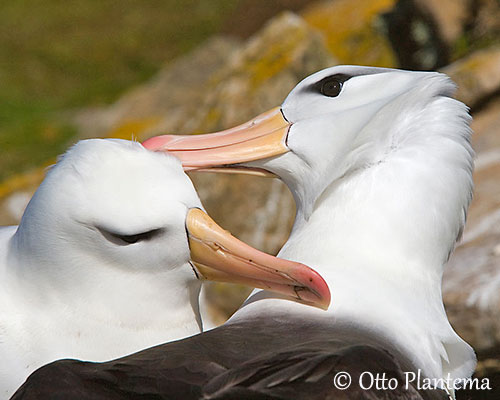
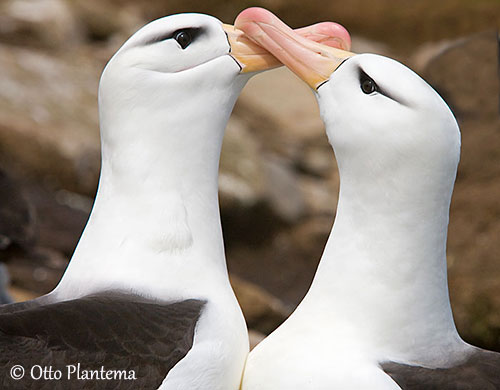
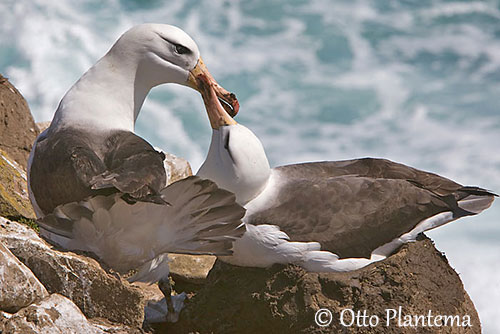
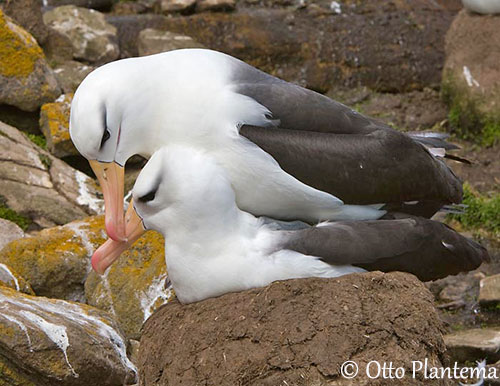
The Black-browed Albatrosses spend most of their time at sea, except during the breeding season. They rest on water when the weather is calm, and can be often seen in groups.
Both adults and young leave the colonies after breeding. The movements of this species are not well understood, in spite of extensive ringing.
The Black-browed Albatross from different breeding areas and even different colonies within the same area have distinct foraging zones, including during incubation period during which male and female forage in different areas. However, during chick-feeding, they forage near the colonies.
The South Atlantic populations perform strong post-breeding migrations northwards. The South Georgian birds migrate to S African waters. Movements are varied and difficult to follow.
The race “impavida” is probably concentrated in S Australian waters, the Tasman Sea and SW Pacific.
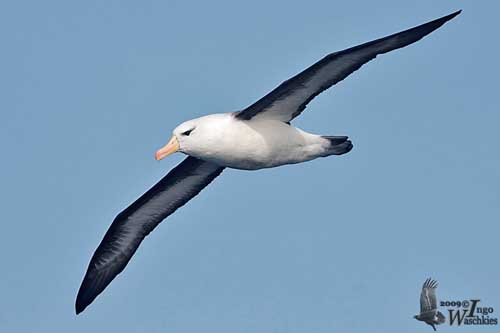
The Black-browed Albatross soars on strong winds with stiff wings. Take-off and landing are always difficult for albatrosses, and they have to run over water or land. However, colonies are established on steep slopes, allowing the birds to propel itself into the air. When landing, they lower the webbed feet to slow the flight before touching ground or water.
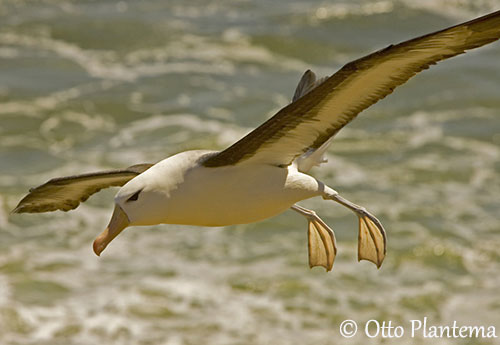
REPRODUCTION OF THIS SPECIES:
The breeding season is annual and starts in September/October.
The Black-browed Albatross builds a large nest with roots, grass and mud, a truncated cone with a depression at top. Within a colony, the nests are about one metre apart.
They breed on remote islands, among tussock grass on steep slopes or on cliff ledges.
They are territorial during the nesting period, and may peck at other birds coming too close to the nest.
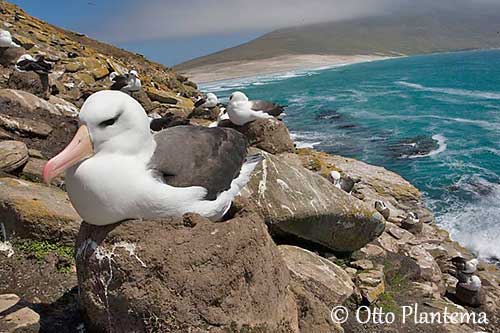
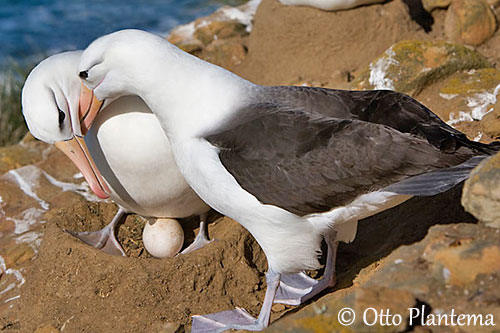
The female lays one single creamy-white egg with dark spots. Both parents incubate during 65-71 days. The downy chick is brooded during the first weeks, and it fledges about 120 days after hatching. Both adults feed and guard it until it fledges and becomes independent. The young will be sexually mature at 7-9 years, but mainly at 11 years old.
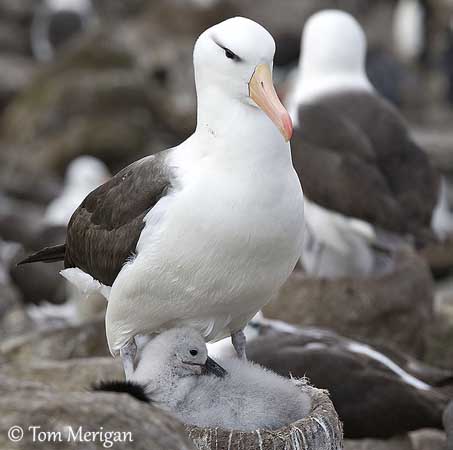
PROTECTION / THREATS / STATUS:
The Black-browed Albatross, like numerous seabirds, is threatened by long-line fishing fleets. Introduced species such as cats and rats, disturb the colonies and kill the chicks. Oil and chemical pollutions, added to plastic ingestion also threaten these birds at sea and on land. Competition for food with fisheries can be potentially significant too.
With a population of about 594 000 breeding pairs, the Black-browed Albatross is classified as Endangered, while the race “impavida” is evaluated as Vulnerable by BirdLife International.
